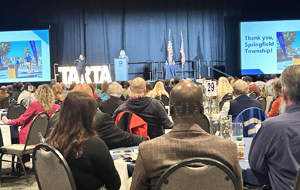 By Fletcher Word
By Fletcher Word
The Truth Editor
“Public transportation is the pulse of progress!”
That was part of the opening statement that the Toledo Area Regional Transit Authority presented during the program on Wednesday, November 15 which offered several hundred attendees a look at the enhanced present and future of public transit in the greater Toledo area.
TARTA Next is the theme of the new expanded and improved services and the TARTA team explained how the system’s services have and will reach into more communities, add routes in communities already served and enhance and improve optional services for local residents.
As Mary Morrison, TARTA Board president noted, the public transit authority’s path to TARTA Next began in 2021 when region-wide voters approved a new funding system, moving to a sales tax rather than the antiquated property tax.
Since then, said Morrison, “projects have been achieved ahead of time and on budget.”
 TARTA Next goals, added Kendra Smith, board vice president, which the system is well on the way to achieving, are extended fixed routes (to more communities such as Springfield Township and Oregon); TARTA Flex for on demand service and improved frequency on existing routes.
TARTA Next goals, added Kendra Smith, board vice president, which the system is well on the way to achieving, are extended fixed routes (to more communities such as Springfield Township and Oregon); TARTA Flex for on demand service and improved frequency on existing routes.
“We want riding the bus to be the easiest part of your day,” caid TARTA CEO Laura Koprowski as she made several announcements about new aspects of transit service:
- TARTA has established a Customer Advisory Committee with community members who use the service. The committee, said Koprowski, provides input to help the transit system maintain a “healthy and productive environment.”
- The expansion to Springfield Township has already led to increased ridership and that TARTA Flex has become an important additional service enabling riders to book service through an app and pay either through the app or with cash in person.
- TARTA Flex will expand into Oregon in January 2024.
- 2100 requests were made this past summer for the Youth Summer Blast Pass which provides rides for youth at no cost.
In addition to the enhanced routes and increase service options, TARTA is moving into the electric vehicle business, said Koprowski. A e-vehicle is already on board for TARPS with five more to arrive in the next several months. In 2026, a total of eight electric vehicles will become part of the regular bus fleet. The electric vehicles and the charging stations to arrive have been funded through a $9 million grant from the Federal Transportation Administration.
 The key to TARTA’s expanded routes, increased frequency and enhanced customer service options, noted Koprowski, was the 2021 ballot initiative that gave Lucas County voters the opportunity to increase the transit system’s funding base.
The key to TARTA’s expanded routes, increased frequency and enhanced customer service options, noted Koprowski, was the 2021 ballot initiative that gave Lucas County voters the opportunity to increase the transit system’s funding base.
“The Lucas County Commissioners passed the resolution to make TARTA countywide,” she said of the 2021 actions.
The major aspects of the TARTA Next plan are those that will strengthen the customer experience. Five classifications define that experience:
- Core routes in the high demand corridors, such along Monroe Street, Dorr Street and Cherry Street, justify a higher investment in service. The frequencies typically are 30 minutes on weekdays and between 30 to 60 minutes on weekends. These routes handle the highest ridership in the system.
- Local routes provide less frequent service – typically around 60 minutes on weekdays and operate on both major corridors and local streets.
- Express/special event routes operate during certain times and provide direct service to major destinations such as the ball park or music venues.
- Toledo Area Regional Paratransit Service (TARPS) complements the fixed route network.
- Microtransit is new and provides same-day, accessible and on-demand service in certain zones. Riders can request a trip when they want to travel and be picked up within a specified wait time.
According to the TARTA website: “An improved transit system will serve as an economic driver and pave the way to education, jobs, entertainment, and more for our community and its people. These customer-focused changes will greatly expand the number of Lucas County and Rossford residents for whom public transportation is a viable option.”
